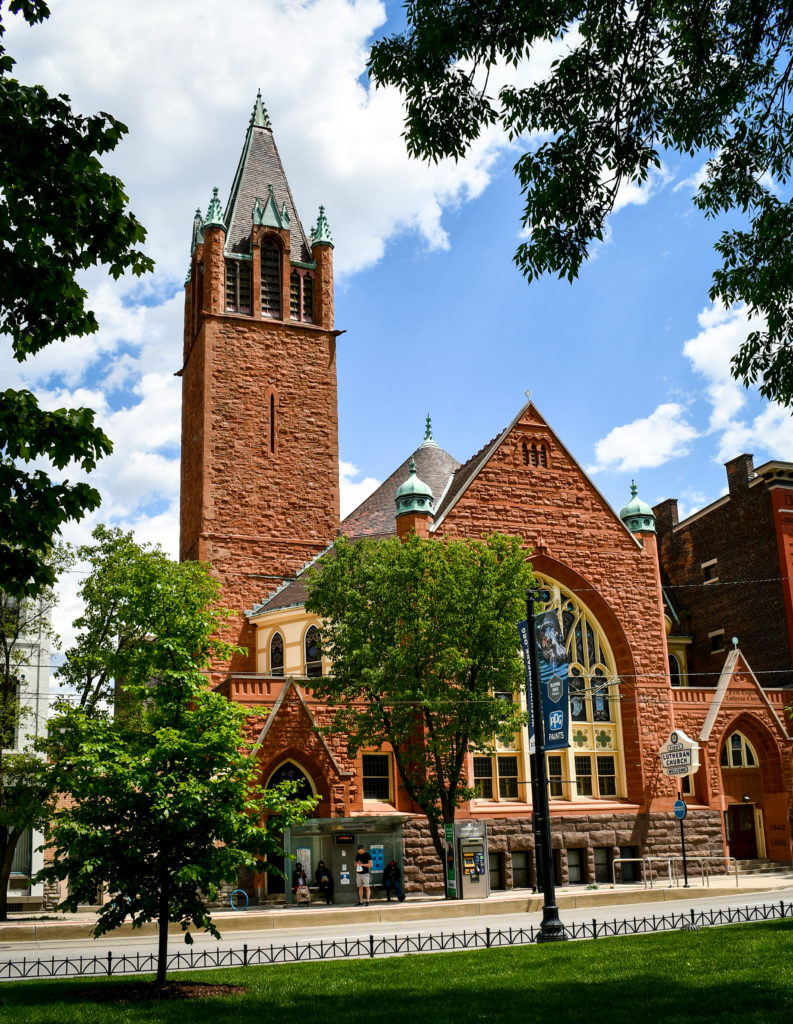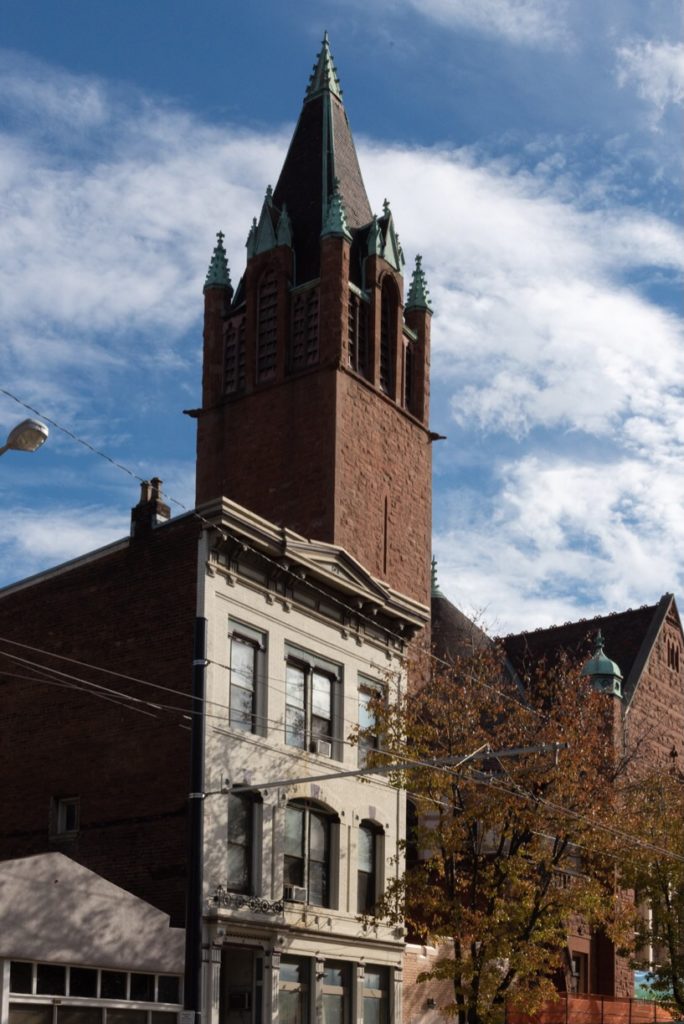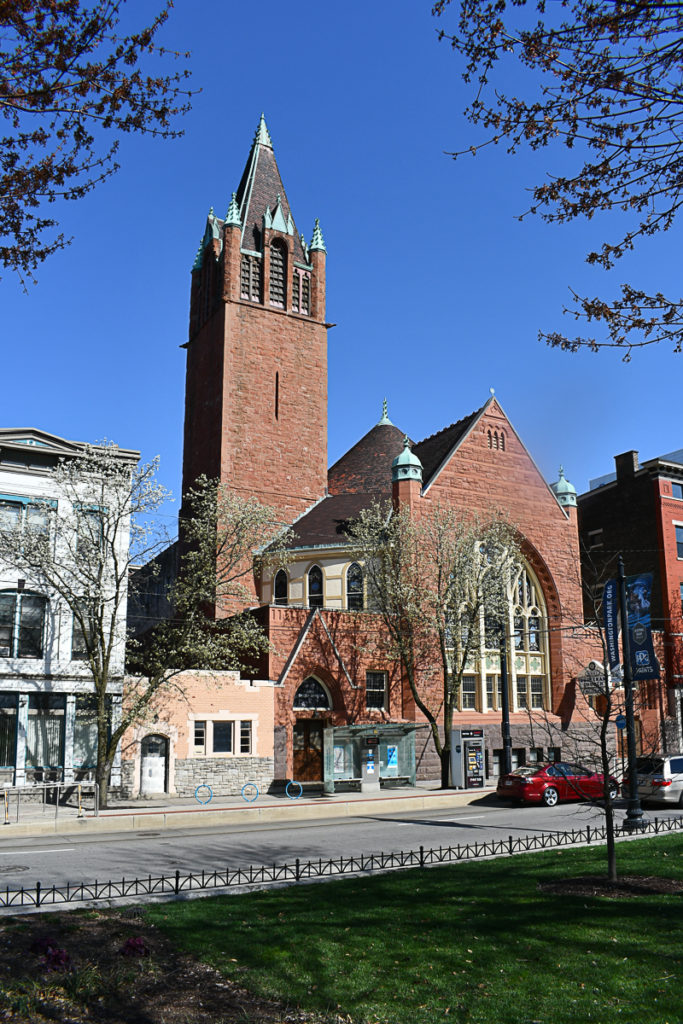There is Still a Chance to Save First Lutheran Bell Tower.
Two recent developments have created an opportunity to avert the planned demolition of the historic First Lutheran Church (FLC) bell tower. The church recently submitted a second engineering approach to Cincinnati building officials to see if a non-seismic repair it would meet the building code requirements. The answer was yes and that opened the door for a simpler repair with costs that are at or below the funds available. The leadership of FLC considered the new option and their obligations for public safety. They conclude that, based on the need to resolve the risks promptly, the responsible course was to continue with the demolition plan. We respect their thoughtful consideration of their responsibilities and their long stewardship of the historic church. With a second report in hand and city acknowledgment that it meets the building code, we urge reconsideration.
The second new development is the outpouring of public support and encouragement that First Lutheran is receiving. It is an unprecedented response and a reflection of how much the community values the iconic bell tower. The messages that the church is receiving show that they are not alone in their stewardship of this historic landmark. Cincinnati Preservation Association is working with many foundations, organizations and the public to increase the funding to save the bell tower on Washington Park.
We are optimistic that the new repair approach and outpouring of public support and funding can provide First Lutheran Church with a path forward to saving the bell tower. What is needed is a little time to confirm the cost of the second approach. Check back here for updates.
First Lutheran Church Bell Tower: A Request for Consideration of an Alternative Approach
Despite strong community support and significant fundraising success, the cost of the original project to repair the bell tower and add seismic foundations is greater than available funding. First Lutheran Church, faced with an emergency hazard order from the City of Cincinnati, recently and reluctantly, entered into a demolition contract for the iconic bell tower. This was a difficult step for the church which has been a responsible steward of the 1895 Crapsey and Brown historic building. The Church’s stewardship of the historic structure has been exceptional and includes a recent façade restoration of $1.3 million. This was funded completely within their small congregation.
The church has received two engineering reports, an initial one by their engineering firm that includes recommendations for seismic retrofitting and a second report from a different firm which outlines a different approach to the repairs. At the urging of community advocates the leadership of First Lutheran Church recently submitted a both engineering reports to the City of Cincinnati building officials for evaluation.
The response letter from Arthur Dahlberg, Director of Buildings and Inspections, acknowledged both approaches could potentially work and noted the competence and professional of both firms. He states that:
“…it is important to recognize that both firms are highly respected and have continuously delivered code compliant solutions for various projects. Second it is important to understand that the criteria defined by the building code should be viewed as the baseline for design. Designs that incorporate higher safety factors are not wrong, rather they are in excess of the code requirements.”
I can affirm Mr. Dahlberg’s statement that the firms are highly respected and deliver code compliant solutions based on my decades of experience. Throughout the First Lutheran project, THP engineers have been open to dialogue. They have been clear in pointing out that their professional opinion is based in other factors than the building code, that they have formed their recommendations that the additional bracing and deep foundation work is needed because they view these as essential to ensure public safety. It is their view that the risk factors result from conditions in the original construction. They have considered this issue carefully, consulted with outside firms on the issue at our request. The firm continues to hold a professional view that public safety is the driving factor for the inclusion of proposing work in their recommendations. We respect that opinion. However, in light of a second report that offers alternate path to achieve safety and code compliance, we respectfully request First Lutheran leadership to convene a meeting between the firms to explore the feasibility of the less expensive alternative.
The second engineering report proposed a reduced scope of repairs that could possibly be made without triggering the building code requirements for seismic retrofitting. This is a standard practice and has been used on most historic buildings restorations in the area. The city letter by Mr. Dahlberg acknowledged that, noting that if the damage to bell tower was not caused by seismic action, it is possible a design that did not include the seismic work could be in compliance with the code. Mr. Dahlberg went on to note that:
“repair work does need to resolve the water infiltration issues and restore the structural system to conditions equivalent to those that existed during the original construction. This includes, but not limited to, all deteriorated connections, structural elements (even as the box girder), and successful transferring of loads generated by the bell tower to the foundation.”
Both engineering approaches appear to address these conditions. If this approach is approved, contractors are prepared to begin promptly. Upon review of Mr. Dahlberg’s letter the Church leadership considered the reply and decided to stand by their prior decision to proceed with demolition. They noted the hazard orders and need to address it in “short order” contained in the letter as major factors in the decision to proceed with demolition. That work could start any day.
Since the two reports were concept statements, detailed plans would be required for a complete review. It is assumed that this second approach is a less costly and may be within reach of funds available for the project. We have respectfully requested that First Lutheran consider this approach prior to the start of demolition of the iconic tower.
The First Lutheran bell tower is an important element of the Washington Park setting. The community has sent numerous letters of support and made pledges to fund the work. Cincinnati Preservation Association has committed significant funding along with many other foundations. The tower deserves an 11th hour chance to remain in place for future generations to experience.
If you would like to join us in the request, please contact the church at pastorbrianflc@gmail.com with an encouraging message of support for First Lutheran’s efforts to save the bell tower. They are in a difficult position and value the thoughts of the community.
Paul Muller, AIA, Executive Director
Cincinnati Preservation Association 8/21/2021

How can you help Save the Bell Tower?
- Please contact the church at pastorbrianflc@gmail.com with an encouraging message of support for First Lutheran’s efforts to save the bell tower. They value the thoughts of the community.
- Donations can help! You can provide funds directly to First Lutheran Church at this link: (Donate here),
- You can also support the bell tower effort at our Revolving Fund at Cincinnati Preservation Association (Donate here)


About the First Lutheran Church Bell Tower
The Problem: as of August 25, 2021: The Church submitted a second engineering approach to the city to see if it could meet the buildings code. The answer was that it could. Despite the potential of the second approach FLC has decided to continue with the demolition of the 1855 bell tower.

The impact of demolition would be disproportionate to the size of the bell tower as it contributes a great deal to the Washington Park setting. The tower adds beauty and individuality to the heart of Over-the-Rhine and is an unparalleled gem of the city skyline. Community investment in the Washington Park arts and cultural district has been substantial. The response on a local and national level have affirmed that wisdom of caring for those historic resources. We have very little time to avoid what would be one of our most regrettable historic resource losses.

The church is currently required to closed for use and, while the congregation takes its responsibility of stewardship for the historic building very seriously, there is a need to return the building to use later this year. The design and funding teams worked to find a phased solution which could use currently available funds to reopen the facility while a longer-term fundraising effort was carried out.
History of First English Lutheran
First Lutheran was constructed in 1895. The architectural firm of Crapsey and Brown designed the church in the English Gothic style. Crapsey’s obituary in the Western Architect & Builder noted that he “made a specialty of church architecture, and as much as, perhaps more, than any other architect of the country, developed the institutional church building.”
First English Lutheran is on the National Register of Historic Places as a contributing structure of the Over-the-Rhine National Register Historic District. The tower itself is a simple stone mass topped with an exuberant series of copper spire caps. The design is unique and represents a high level of architectural skill. The faith community of First Lutheran has a long history of commitment to helping others and to the cause of equality. Women were granted the right to vote on parish matters in the late 19th century. Today First Lutheran continues that commitment by providing spaces for arts and community groups and by supporting many programs for people in need. Of the 22,000 people who used the building last year, 20,000 were people attending arts programs, community meetings or accessing programs for people in need. The church values its role as a low cost venue supporting the Washington Park arts district.

The bell tower is an important of the historic setting of Washington Park
Community Use of the Meeting and
Performance Spaces
Church Serves as an Affordable Venue for Arts and Community Groups
- Ninety percent of the foot traffic at First is non-First Lutheran activity. Over 20,000 people in 2019 which could expand to 100,000 with completed restoration and staff increase.
- Type of Uses That Fill the Year:
- Recitals (many for CCM Students, SCPA cello students)
- Rehearsal space (YPCC is biggest partner, CSO musicians)
- Concerts (Queen City Concert Band, YPCC, Concert Nova, Saengerfest)
- Theater (Fringe Festival)
- Recovery support groups (Narcotics Anonymous, AA)
Food/clothing needs support - Affordable meeting/event space for non-profit organizations (OTRCH, Tender Mercies, SCPA)
- Community meeting/presentation space for events (OTR History Museum, NKY Chamber)
- Weddings (need not be a member, open to any tradition)
- Restrooms are always open for free public use during big Washington Park events such as BLINK, Lumenocity
The interior spaces have excellent acoustics. They host choral performances, lectures and community meetings on a regular basis. First Lutheran seeks to expand these uses with future accessibility projects.

Previous Investment in the Historic Building
The parish has spent $1.3 million on facade and interior restoration in the last few years. They received recognition for this work from the OTR Chamber of Commerce in 2019. The parish has a deep commitment to supporting disadvantaged residents of OTR and provides a number of programs as part of this mission. The building has significant accessibility challenges and as part of their commitment to welcoming the community to use the spaces, an elevator project remains a high priority. First Lutheran is open to saving the bell tower but does not have the financial means to do so nor do they have the means to do any other work. Their intent has always been to restore the tower but right now they do not have money for the tower or for the elevator project.

A Convergence of Ideals and Architectural Expression

The design represents a departure from direct replication of Gothic architecture. Its simplicity and taut surface treatments are part of a progressive movement in architecture of the late 19th century. This forward-looking approach in architecture underscores the progressive congregation that provided women with voting rights and commitment to services in English rather than German. This open-minded approach remains a defining feature of First Lutheran as it serves people of Cincinnati and Northern Kentucky. The bell tower is a reminder to the community that, even in a prospering Over-the-Rhine, this extraordinary congregation continues its 125 years commitment to supporting and welcoming those in need.
The building expressed a point of view in 1895, it continues to articulate that message today.
The origins of First Lutheran stylistic innovations can be seen in the mid 19th century work of English architect Gilbert Scott. His High Victorian Gothic Revival buildings departed from literal reproduction of their Gothic sources. The design also has elements of Richardsonian Romanesque, a style which arrived in Cincinnati with the construction of City Hall. The tower of First Lutheran makes an enduring impression with ethereal silhouettes where his building met the sky.
The progressive nature of the design is acknowledged in the fact that it was presented as example of “Modern Styles” in the 1897 Manual of Ecclesiastical Architecture.
In noting that the design has more in common with Cincinnati’s City Hall that Gothic churches, architectural historian Walter Langsam recently called it “Richardsonian Romanesque architecture made swevlt.”



The building was recognized as a progressive departure the reflected the views of the congregants. In writing about the building in 1897 William Martin said “(First Lutheran’s building) is like those small flowers by the wayside. Their modest show hides their beauty, but when they are plucked and beheld, their beauty of form and rare coloring make them rival easily the more obtrusive flower beauties which hang in our gardens.”
Manual of Ecclesiastical Architecture,
William Wallace Martin, 1897



History of First Lutheran Church
First Lutheran was constructed in 1895. The architectural firm of Crapsey and Brown designed the church in the English Gothic style. Crapsey’s obituary in the Western Architect & Builder noted that he “made a specialty of church architecture, and as much as, perhaps more, than any other architect of the country, developed the institutional church building.”
First English Lutheran is on the National Register of Historic Places as a contributing structure of the Over-the-Rhine National Register Historic District. The tower itself is a simple stone mass topped with an exuberant series of copper spire caps. The design is unique and represents a high level of architectural skill. The faith community of First Lutheran has a long history of commitment to helping others and to the cause of equality. Women were granted the right to vote on parish matters in the late 19th century. Today First Lutheran continues that commitment by providing spaces for arts and community groups and by supporting many programs for people in need. Of the 22,000 people who used the building last year, 20,000 were people attending arts programs, community meetings or accessing programs for people in need. The church values its role as a low cost venue supporting the Washington Park arts district.


